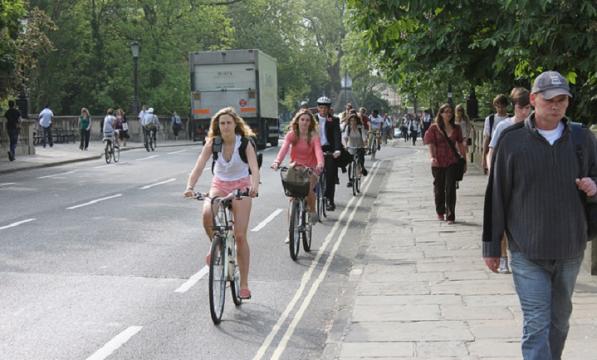Cycling and Walking Investment Strategy a step closer

It is being hailed as the first serious step towards delivering on David Cameron's commitment to "kick-start a cycling revolution". The Cycling and Walking Investment Strategy now forms part of the Infrastructure Act 2015 following lobbying by UK cycling bodies.
The law, which applies in England only, requires the Government to set a strategy that details the objectives and the financial resources made available. During the election the Prime Minister in response to the #ChooseCycling Network said that, “we want [cycling] to be the natural choice for shorter journeys” while he also committed to funding cycling by £10 per head in support of the Vote Bike campaign led by CTC, the national cycling charity.
The recently published Roads Investment Strategy (RIS) provides a format which the Cycling and Walking Investment Strategy (CWIS) is likely to follow. The RIS runs from 2015-2021 and contains a strategic vision, timeline, statement of funds, infrastructure plan and performance specification.
However, funding for cycling is set to reduce dramatically from next year when the Local Sustainable Transport Fund comes to an end, potentially leaving a gap in cycle funding until the CWIS is produced. The Government claims cycle investment for England stands at £6 per head, but without renewed commitment this will reduce to less than £2 per head, well below the promised £10 per head figure.
Chris Boardman British Cycling’s policy adviser said:
“The Government deserves praise for committing to this strategy but it’s what happens next which is the real test. Investment in cycling has slowly increased over the years but is due to run out soon. We now need to think long-term to get that level of consistency needed if we are to hit the government’s target.
“This is not new money but a reprioritisation of existing funds so that we can capture the health, economic and transformational powers of cycling to transform our towns and cities. Compared to the cost of roads or HS2 cycling is peanuts, just 5% of transport spend would begin to transform the country and make cycling an integrated part of daily life.”
Jon Snow, Channel 4 Broadcaster and CTC President, said:
“Not since 1888 when the cycle was classified as a carriage and legally allowed on the UK’s roads, has the Government introduced such a step change for cycling.
“To maximise its economic and societal benefits though, cycling needs at least £10ph investment annually - rising to £20 as cycle use increases - backed by national design standards to ensure this money is well spent.”
Notes to editors
1. Link to legislation on the Cycling and Walking Investment Strategy (CWIS) http://www.legislation.gov.uk/uksi/2015/1543/made
2. Timeline of the progress of CWIS:
- 26 August 2014: CTC and a coalition of sustainable transport groups launch campaign for a Cycling & Walking Investment Strategy (CWIS).
- 04 December: CTC launches an online action inviting supporters to enlist their MPs' backing for CWIS.
- 20 January 2015: CTC launches 'The Economic Cycle', research showing that England's economy could gain £1/4 trillion of benefits by meeting the target of the parliamentary 'Get Britain Cycling' report to boost cycle use to 25% of trips. By then, over 5800 CTC members and supporters had contacted their MPs calling them to back the addition of CWIS to the Infrastructure Bill.
- 22 January: Government agrees to include CWIS in the Infrastructure Bill. It was voted through the Commons on 26th January, and the Lords on 9th February, with the Infrastructure Act receiving Royal Assent on 11th February.
- 24 June: Transport minister confirms that he has instructed officials to draft a Commencement Order for the CWIS
- 31 July: Commencement of CWIS confirmed
3. The All Party Parliamentary Cycling Group’s “Get Britain Cycling” (GBC) report (2013) recommended an increase of cycle use from less than 2 per cent of all journeys (current levels) to 10 per cent by 2025 and 25 per cent by 2050, with corresponding funding levels of at least £10 per head by 2025 and £25 per head by 2050. By comparison the current Dutch spend £24 per head. For further information on the Get Britain Cycling inquiry and report, see https://www.ctc.org.uk/get-britain-cycling.
4. Cycle Funding in England for 2015/16:
- £12m for Bikeability (cycle training)
- £15m for the railway cycling programme
- £64.5m in local sustainable transport funding
- £1.5m in national cycling support
- £16.7m spent on cycling by Highways England
- £38m for Cycle City Ambition Grant (part of the £114m announced by former Deputy Prime Minister Nick Clegg for eight cities over three years)
- £145m spent by TfL
Total: £292.7m, which is £5.52 per head of 53m population in England; not including London funding is at £3.33 per head, based on London population of 8.63m. This sum is further skewed by a large proportion of funding being based in 8 cities, leaving parts of the England with investment of less than £1 per head.
Press contact information
CTC Press Office
Email: publicity@ctc.org.uk
Telephone: 0844-736-8453


